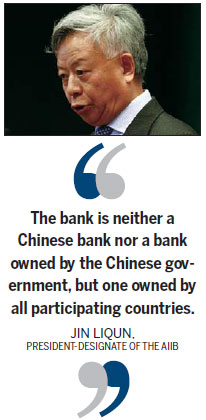New Asian bank to lend up to $15b a year
Updated: 2015-12-04 08:24
By Zheng Xin(China Daily Europe)
|
|||||||||||
The Asian Infrastructure Investment Bank, the new international development bank initiated by China, plans to lend $10 billion to $15 billion a year for the first five or six years, a senior official said on Dec 1.
The new lender, which will be inaugurated this month and plans to conduct its first board meeting in January, will support infrastructure development and connectivity in Asia, says Jin Liqun, president-designate of the AIIB.
"The bank is neither a Chinese bank nor a bank owned by the Chinese government, but one owned by all participating countries," says Jin in Beijing.
Jin did not specify any priority projects for the AIIB or the countries that will be the beneficiaries of initial loans, but says around 30 countries are waiting in line for membership and this would increase the bank's capital.
"There are 50 applicants in the fray for the position of vice-president of the AIIB," says Jin, the former chairman of investment bank China International Capital Corp.
Urging European experts to join the lender, Jin says their services are necessary for the AIIB during the growth phase. Going forward, the AIIB will look to jointly fund infrastructure projects in Europe.
"The AIIB should not be limited to Asian countries, and it can only succeed if European and countries from other continents join."

Jin, however, says the idea of having more members is not because Asia is not up to the job, but rather the emphasis that developed countries, particularly those in Europe, could share their experiences in running international institutions.
"It is crazy to reject any other countries and not to seek advice in running the bank. For European countries, joining the AIIB is an opportunity to do different things and do things differently," Jin says.
The United Kingdom applied to join the AIIB as a founding member in March, and this has prompted more European countries to follow suit, he says.
Suma Chakrabarti, president of the European Bank for Reconstruction and Development, said earlier that the AIIB has important implications for the EBRD as the combined strength of the two could allow them to take on much larger projects.
The EBRD says it is keenly eyeing opportunities to work closely with the AIIB.
According to Jin, the US dollar will be the operating currency of the AIIB for its convenience, while the bank will also take into consideration financing requests in other currencies, including the yuan.
In response to doubts and skepticism about the creation of the AIIB and whether it will compete with existing institutions, Jin says each phase of development should have a new type of modern institution to meet the needs of that time, citing examples like the Asian Development Bank set up half a century ago.
Allaying concerns on what China wants to do and whether it was necessary to set up the AIIB, Jin says there is no doubt that Asia's infrastructure development will take off in the next 15 to 20 years.
"It's important to explore the possibilities of a new type of bank and a new approach to deal with the emerging economic and social development issues, as the backlog in Asia's infrastructure development has contributed to a bottleneck in social development, climate change and other serious problems," he says.
The bank has already initiated talks with other institutions, including the ADB and the World Bank, he says.
Cyril Muller, former director for banking and debt management in the World Bank Treasury, said in March during the Boao Forum for 2015 Asia Annual Conference that the AIIB could learn from previous experience and cooperate with existing organizations.
zhengxin@chinadaily.com.cn
(China Daily European Weekly 12/04/2015 page22)
Today's Top News
Xi in South Africa to boost China-Africa cooperation
SOEs face headwinds as 21% witness profits decline
President Xi arrives at South Africa for state visit
China ready for risks after yuan included in SDR
Premier League coaches to aid China's soccer goal
Chinese companies invest in City Football Group
Investment expected as Xi arrives in Zimbabwe
Xi's Zimbabwe visit to elevate bilateral ties to new high
Hot Topics
Lunar probe , China growth forecasts, Emission rules get tougher, China seen through 'colored lens', International board,
Editor's Picks

|

|

|

|

|

|






